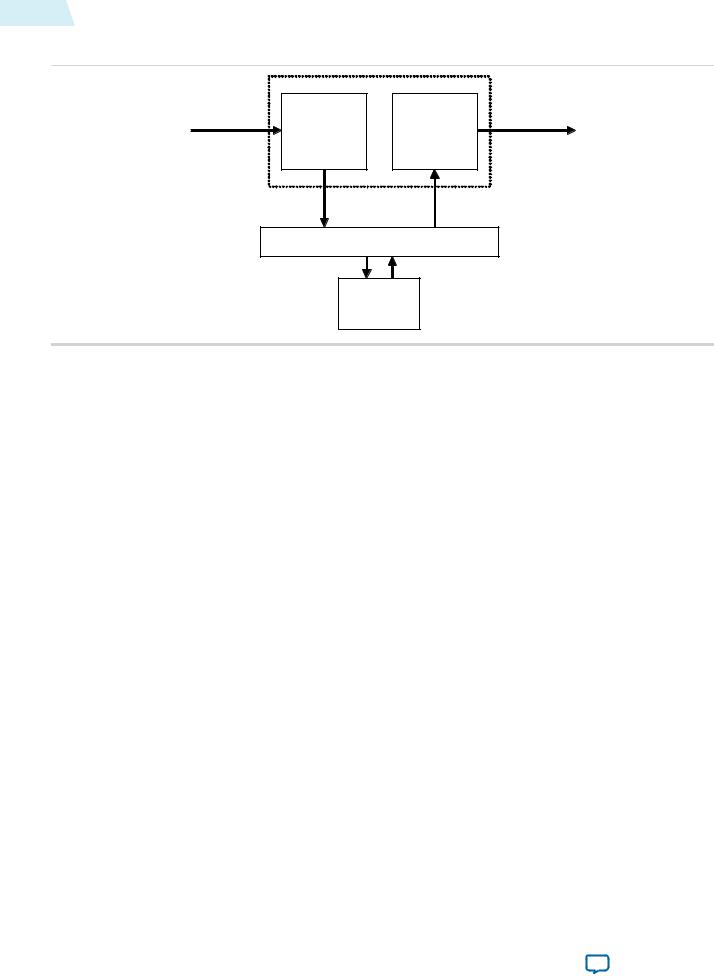
- •Contents
- •1. Video and Image Processing Suite Overview
- •Release Information
- •Device Family Support
- •Latency
- •In-System Performance and Resource Guidance
- •Stall Behavior and Error Recovery
- •2. Interfaces
- •Video Formats
- •Avalon-ST Video Protocol
- •Video Data Packets
- •Static Parameters of Video Data Packets
- •Control Data Packets
- •Ancillary Data Packets
- •User-Defined and Altera-Reserved Packets
- •Packet Propagation
- •Transmission of Avalon-ST Video Over Avalon-ST Interfaces
- •Packet Transfer Examples
- •Avalon-MM Slave Interfaces
- •Specification of the Type of Avalon-MM Slave Interfaces
- •Avalon-MM Master Interfaces
- •Specification of the Type of Avalon-MM Master Interfaces
- •Buffering of Non-Image Data Packets in Memory
- •3. Getting Started
- •IP Catalog and Parameter Editor
- •Specifying IP Core Parameters and Options
- •Installing and Licensing IP Cores
- •OpenCore Plus IP Evaluation
- •4. Clocked Video Interface IP Cores
- •Control Port
- •Clocked Video Input Format Detection
- •Interrupts
- •Clocked Video Output Video Modes
- •Interrupts
- •Generator Lock
- •Underflow and Overflow
- •Timing Constraints
- •Handling Ancillary Packets
- •Modules for Clocked Video Input II IP Core
- •Clocked Video Interface Parameter Settings
- •Clocked Video Interface Signals
- •Clocked Video Interface Control Registers
- •5. 2D FIR Filter IP Core
- •Calculation Precision
- •Coefficient Precision
- •Result to Output Data Type Conversion
- •2D FIR IP Core Parameter Settings
- •2D FIR Filter Signals
- •2D FIR Filter Control Registers
- •6. Video Mixing IP Cores
- •Alpha Blending
- •Video Mixing Parameter Settings
- •Video Mixing Signals
- •Video Mixing Control Registers
- •7. Chroma Resampler IP Core
- •Horizontal Resampling (4:2:2)
- •Vertical Resampling (4:2:0)
- •Chroma Resampler Parameter Settings
- •Chroma Resampler Signals
- •8. Video Clipping IP Cores
- •Video Clipping Parameter Settings
- •Video Clipping Signals
- •Video Clipping Control Registers
- •9. Color Plane Sequencer IP Core
- •Combining Color Patterns
- •Rearranging Color Patterns
- •Splitting and Duplicating
- •Subsampled Data
- •Color Plane Sequencer Parameter Settings
- •Color Plane Sequencer Signals
- •10. Color Space Conversion IP Cores
- •Input and Output Data Types
- •Color Space Conversion
- •Result of Output Data Type Conversion
- •Color Space Conversion Parameter Settings
- •Color Space Conversion Signals
- •Color Space Conversion Control Registers
- •11. Control Synchronizer IP Core
- •Using the Control Synchronizer IP Core
- •Control Synchronizer Parameter Settings
- •Control Synchronizer Signals
- •Control Synchronizer Control Registers
- •12. Deinterlacing IP Cores
- •Deinterlacing Methods
- •Bob with Scanline Duplication
- •Bob with Scanline Interpolation
- •Weave
- •Motion-Adaptive
- •Sobel-Based HQ Mode
- •Pass-Through Mode for Progressive Frames
- •Frame Buffering
- •Frame Rate Conversion
- •Bandwidth Requirement Calculations for 10-bit YCbCr Video
- •Behavior When Unexpected Fields are Received
- •Handling of Avalon-ST Video Control Packets
- •Deinterlacing Parameter Settings
- •Deinterlacing Signals
- •Deinterlacing Control Registers
- •Design Guidelines for Broadcast Deinterlacer IP Core
- •13. Frame Reader IP Core
- •Single-Cycle Color Patterns
- •Frame Reader Output Pattern and Memory Organization
- •Frame Reader Parameter Settings
- •Frame Reader Signals
- •Frame Reader Control Registers
- •14. Frame Buffer IP Cores
- •Double Buffering
- •Triple Buffering
- •Locked Frame Rate Conversion
- •Handling of Avalon-ST Video Control Packets
- •Color Format
- •Frame Buffer Parameter Settings
- •Frame Buffer Signals
- •Frame Buffer Control Registers
- •15. Gamma Corrector IP Core
- •Gamma Corrector Parameter Settings
- •Gamma Corrector Signals
- •Gamma Corrector Control Registers
- •16. Interlacer IP Core
- •Interlacer Parameter Settings
- •Interlacer Signals
- •Interlacer Control Registers
- •17. Scaler II IP Core
- •Nearest Neighbor Algorithm
- •Bilinear Algorithm
- •Bilinear Algorithmic Description
- •Polyphase and Bicubic Algorithm
- •Double-Buffering
- •Polyphase Algorithmic Description
- •Choosing and Loading Coefficients
- •Edge-Adaptive Scaling Algorithm
- •Scaler II Parameter Settings
- •Scaler II Signals
- •Scaler II Control Registers
- •18. Video Switching IP Cores
- •Mixer Layer Switching
- •Video Switching Parameter Settings
- •Video Switching Signals
- •Video Switching Control Registers
- •19. Test Pattern Generator IP Cores
- •Test Pattern
- •Generation of Avalon-ST Video Control Packets and Run-Time Control
- •Test Pattern Generator Parameter Settings
- •Test Pattern Generator Signals
- •Test Pattern Generator Control Registers
- •20. Trace System IP Core
- •Trace System Parameter Settings
- •Trace System Signals
- •Operating the Trace System from System Console
- •Loading the Project and Connecting to the Hardware
- •Trace Within System Console
- •TCL Shell Commands
- •21. Avalon-ST Video Monitor IP Core
- •Packet Visualization
- •Monitor Settings
- •Avalon-ST Video Monitor Parameter Settings
- •Avalon-ST Video Monitor Signals
- •Avalon-ST Video Monitor Control Registers
- •Avalon-ST Video Class Library
- •Running the Tests
- •Video File Reader Test
- •Example Test Environment
- •Video Field Life Cycle
- •Constrained Random Test
- •Complete Class Reference
- •c_av_st_video_control
- •c_av_st_video_data
- •c_av_st_video_file_io
- •c_av_st_video_item
- •c_av_st_video_source_sink_base
- •c_av_st_video_sink_bfm_’SINK
- •c_av_st_video_source_bfm_’SOURCE
- •c_av_st_video_user_packet
- •c_pixel
- •Raw Video Data Format
- •Cadence Detection and Reverse Pulldown in the Deinterlacer II IP Core
- •Document Revision History
- •How to Contact Altera

Frame Buffer IP Cores 14
2015.01.23
UG-VIPSUITE |
Subscribe |
Send Feedback |
The Frame Buffer IP cores buffer video frames into external RAM.
IP Cores |
|
Feature |
|
|
|
Frame Buffer |
|
• Buffers progressive and interlaced video fields. |
|
|
• Supports double and triple buffering with a range of |
|
|
options for frame dropping and repeating |
|
|
• Supports 1 pixel per transmission. |
|
|
|
Frame Buffer II |
|
• Buffers progressive and interlaced video fields. |
•Supports double and triple buffering with a range of options for frame dropping and repeating
•Supports up to 4 pixels per transmission.
•When frame dropping and frame repeating are not allowed—the IP core provides a double-buffering function that can help solve throughput issues in the data path.
•When frame dropping and/or frame repeating are allowed—the IP core provides a triple-buffering function that can be used to perform simple frame rate conversion.
The Frame Buffer IP cores have two basic blocks:
•a writer which stores input pixels in memory
•a reader which retrieves video frames from the memory and produces them as outputs
© 2015 Altera Corporation. All rights reserved. ALTERA, ARRIA, CYCLONE, ENPIRION, MAX, MEGACORE, NIOS, QUARTUS and STRATIX words and logos are trademarks of Altera Corporation and registered in the U.S. Patent and Trademark Office and in other countries. All other words and logos identified as trademarks or service marks are the property of their respective holders as described at www.altera.com/common/legal.html. Altera warrants performance of its semiconductor products to current specifications in accordance with Altera's standard warranty, but reserves the right to make changes to any products and services at any time without notice. Altera assumes no responsibility or liability arising out of the application or use of any information, product, or service described herein except as expressly agreed to in writing by Altera. Altera customers are advised to obtain the latest version of device specifications before relying on any published information and before placing orders for products or services.
www.altera.com
ISO 9001:2008 Registered
101 Innovation Drive, San Jose, CA 95134

14-2 |
Double Buffering |
UG-VIPSUITE |
|
2015.01.23 |
|||
|
|
Figure 14-1: Frame Buffer Block Diagram
Avalon-ST Input |
Avalon-ST Output |
(din) |
(dout) |
Avalon-MM Master |
Avalon-MM Master |
(write_master) |
(read_master) |
Arbitration Logic
DDR2
Double Buffering
For double-buffering, the IP cores use two frame buffers in external RAM.
•The writer uses one buffer to store input pixels.
•The reader locks the second buffer that reads the output pixels from the memory.
•When both writer and reader complete processing a frame, the buffers are exchanged.
•The input frame can then be read back from the memory and sent to the output, while the buffer that has just been used to create the output can be overwritten with fresh input.
•This feature used when:
•The frame rate is the same both at the input and at the output sides but the pixel rate is highly irregular at one or both sides.
•A frame has to be received or sent in a short period of time compared with the overall frame rate. For example, after the Clipper IP core or before one of the foreground layers of the Alpha Blending Mixer Clipper IP core.
Triple Buffering
For triple-buffering, the IP cores use three frame buffers in external RAM.
Altera Corporation |
Frame Buffer IP Cores |
|
|
Send Feedback

UG-VIPSUITE 2015.01.23
Locked Frame Rate Conversion |
14-3 |
•The writer uses one buffer to store input pixels.
•The reader locks the second buffer that reads the output pixels from the memory.
•The third buffer is a spare buffer that allows the input and the output sides to swap buffers asynchro nously. The spare buffer can be clean or dirty.
•Considered clean if it contains a fresh frame that has not been sent.
•Considered dirty if it contains an old frame that has already been sent by the reader component.
•When the writer completes storing a frame in memory, it swaps its buffer with the spare buffer if the spare buffer is dirty.
•The buffer locked by the writer becomes the new spare buffer and is clean because it contains a fresh frame.
•If the spare buffer is already clean when the writer completes writing the current input frame:
•If dropping frames is allowed—the writer drops the newly received frame and overwrites its buffer with the next incoming frame.
•If dropping frames is not allowed—the writer stalls until the reader completes its frame and replaces the spare buffer with a dirty buffer.
•When the reader completes reading and produces a frame from memory, it swaps its buffer with the spare buffer if the spare buffer is clean.
•The buffer locked by the reader becomes the new spare buffer; and is dirty because it contains an old frame that has been sent previously.
•If the spare buffer is already dirty when the reader completes the current output frame:
•If repeating frames is allowed—the reader immediately repeats the frame that has just been sent.
•If repeating frames is not allowed—the reader stalls until the writer completes its frame and replaces the spare buffer with a clean buffer.
Locked Frame Rate Conversion
The locked frame rate conversion allows the IP core to synchronize the input and output frame rates through an Avalon-MM slave interface.
The decision to drop and repeat frames for triple-buffering is based on the status of the spare buffer. Because the input and output sides are not tightly synchronized, the behavior of the Frame Buffer IP core is not completely deterministic and can be affected by the burstiness of the data in the video system. This may cause undesirable glitches or jerky motion in the video output, especially if the data path contains more than one triple buffer.
By controlling the dropping or repeating behavior, the IP core can keep the input and output synchron ized. To control the dropping or repeating behavior, you must select triple-buffering mode and turn on
Support for locked frame rate conversion in the Frame Buffer parameter editor.
You can select and change the input and output rates at run time. Using the slave interface, it is also possible to enable or disable synchronization at run time to switch between the user-controlled and flowcontrolled triple-buffering algorithms as necessary.
Handling of Avalon-ST Video Control Packets
The Frame Buffer IP core stores non-image data packets in memory.
Frame Buffer IP Cores |
Altera Corporation |
|
|
Send Feedback

14-4 |
Color Format |
UG-VIPSUITE |
|
2015.01.23 |
|||
|
|
The user packets are never repeated and they are not dropped as long as memory space is sufficient. The control packets are not stored in memory.
•The input control packets are processed and discarded by the writer.
•The output control packets are regenerated by the reader.
When a frame is dropped by the writer, it keeps the preceding non-image data packets and sends with the next frame that is not dropped. When a frame is repeated by the reader, it is repeated without the packets that preceded it.
The behavior of the Frame Buffer IP core is not determined by the field dimensions announced in the Avalon-ST Video control packets and relies exclusively on the startofpacket and endofpacket signals to delimit the frame boundaries. The Frame Buffer IP core can consequently handle and propagate mislabeled frames. You can use this feature in a system where dropping frame is not an acceptable option. The latency introduced during the buffering could provide enough time to correct the invalid control packet.
The buffering and propagation of image data packets incompatible with preceding control packets is an undesired behavior in most systems. Dropping invalid frames is often a convenient and acceptable way of dealing with glitches from the video input. You can parameterize the Frame Buffer IP core to drop all mislabeled fields or frames at compile time. Turning on the Frame repetition parameter guarantees that the reader keeps on repeating the last valid received frame— freezes the output—when the input drops.
Color Format
Color definitions for YCbCr and RGB combinations are different.
Table 14-1: Color Definition for 8-bit YCbCr and RGB Combinations
Any value from 0 to 255 that is not valid for YCbCr format may be valid for RGB format.
Color |
|
8-bit YCbCr |
|
8-bit RGB |
|
|
|
|
|
Light gray |
|
180, 128, 128 |
|
180, 180, 180 |
|
|
|
|
|
Yellow |
|
162, 44, 142 |
|
180, 180, 16 |
|
|
|
|
|
Cyan |
|
131, 156, 44 |
|
16, 180, 180 |
|
|
|
|
|
Green |
|
112, 72, 58 |
|
16, 180, 16 |
|
|
|
|
|
Magenta |
|
84, 184, 198 |
|
180, 16, 180 |
|
|
|
|
|
Red |
|
65, 100, 212 |
|
180, 16, 16 |
|
|
|
|
|
Blue |
|
35, 212, 114 |
|
16, 180, 16 |
|
|
|
|
|
White |
|
235, 128, 128 |
|
235, 235, 235 |
|
|
|
|
|
Black |
|
16, 128, 128 |
|
16, 16, 16 |
|
|
|
|
|
Altera Corporation |
Frame Buffer IP Cores |
|
|
Send Feedback
